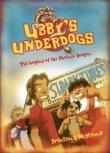 957394385132275642.jpg
957394385132275642.jpg
 957394385132275642.jpg
957394385132275642.jpg
Ubby is a smart, young Aboriginal girl who is twice as tough as the streets she lives on. She is the leader of a rag-tag group of youth known as the 'Underdogs'. When Ubby meets Sai Fong, a Chinese girl who has arrived fresh off the boat from Beijing, street life in Broome takes on a multitude of new dimensions. From the moment the two girls meet, they find themselves immersed in a series of bizarre adventures influenced by Aboriginal and Chinese myths and legend, and secrets never before exposed.
'This is a heroic tale that measures the limits of courage and friendship. Ubby's Underdogs: The Legend of the Phoenix Dragon boasts a multifaceted narrative with staggering graphic detail in order to introduce a series of complex characters with links to other worlds. Amidst a backdrop of fictionalised Aboriginal and Chinese mythology in the unique multicultural town of Broome, Brenton's first graphic novel leaves you gasping for air and in anticipation of things to come.'
(Source: Magabala Books website; http://www.magabala.com)
Unit Suitable For
AC: Year 7 (NSW Stage 4)
Themes
bravery, bullying, colonialism, corruption, friendship, gender roles and stereotypes, humour, interracial, magic realism, Myths and Legends, racism, satire, social class
General Capabilities
Critical and creative thinking, Ethical understanding, Information and communication technology, Intercultural understanding, Literacy, Personal and social
Cross-curriculum Priorities
Aboriginal and Torres Strait Islander histories and cultures, Asia and Australia's engagement with Asia
"The ‘Ubby’s Underdogs’ books are the first graphic novels published by Magabala Books,representing an innovation which maintains the inventiveness characteristic of Magabala’s picture books. The trilogy’s treatment of the Underdogs’ exploits in multicultural Broome foregrounds the encounter between Aboriginal and Chinese cultural traditions. By drawing on a blend of cultural signifiers, the novels display the carnivalesque qualities described by Mikhail Bakhtin in Rabelais and His World (1984). In McKenna’s novels carnivalesque scenes, polyglot voices and intercultural dialogues give rise to a transformative vision of a community which resists monologic authoritarianism. Like graphic novels more generally, the Underdogs novels rely on visual, verbal and cultural stereotypes to enable rapid identification of characters of various ethnicities. They transform such stereotypical and exoticised figures through modes of representation and narrative which privilege the ‘culture of folk carnival humour’ (Bakhtin 1984, p. 4) to present negotiations between and across cultures in the setting of post-war Broome." (Introduction)
"The ‘Ubby’s Underdogs’ books are the first graphic novels published by Magabala Books,representing an innovation which maintains the inventiveness characteristic of Magabala’s picture books. The trilogy’s treatment of the Underdogs’ exploits in multicultural Broome foregrounds the encounter between Aboriginal and Chinese cultural traditions. By drawing on a blend of cultural signifiers, the novels display the carnivalesque qualities described by Mikhail Bakhtin in Rabelais and His World (1984). In McKenna’s novels carnivalesque scenes, polyglot voices and intercultural dialogues give rise to a transformative vision of a community which resists monologic authoritarianism. Like graphic novels more generally, the Underdogs novels rely on visual, verbal and cultural stereotypes to enable rapid identification of characters of various ethnicities. They transform such stereotypical and exoticised figures through modes of representation and narrative which privilege the ‘culture of folk carnival humour’ (Bakhtin 1984, p. 4) to present negotiations between and across cultures in the setting of post-war Broome." (Introduction)